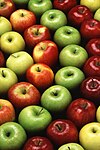
Gala is a clonally propagated apple cultivar with a mild and sweet flavour. In 2018, it surpassed Red Delicious as the apple cultivar with the highest production in the United States, according to the US Apple Association. It was the first time in over 50 years that any cultivar was produced more than Red Delicious.
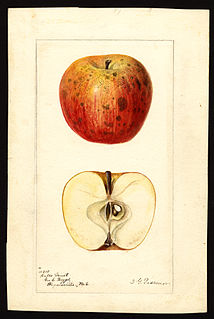
'Ralls Janet' is an apple cultivar that is also known by many other names. It has been used extensively in modern apple breeding, and has several commercially important offspring. It was grown at Monticello by Thomas Jefferson. It has been said that the name derives from Edmond-Charles Genet, a Frenchman who gave cuttings to Thomas Jefferson, who then passed them on to Virginia nurseryman M. Caleb Ralls, but this claim was not made until about 100 years after the apple became known and may not be accurate.

The 'Roxbury Russet' is an apple cultivar, believed to be the oldest apple cultivar bred in the United States, having first been discovered and named in the mid-17th century in the former Town of Roxbury, part of the Massachusetts Bay Colony southwest of Boston. It is known by several other names including 'Boston Russet', 'Putnam Russet', and 'Sylvan Russet'.
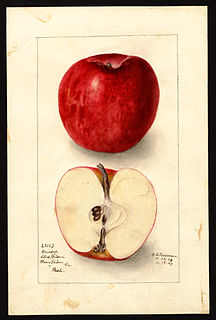
Winesap is an old apple cultivar of unknown origin, dating at least to American colonial times. Its apples are sweet with a tangy finish. They are used for eating, cooking, and cider.

Momordica balsamina is a tendril-bearing annual vine native to the tropical regions of Africa, introduced and invasive in Asia, Australia, Central America, and North America, where they have been found in some parts of Florida. It has pale yellow, deeply veined flowers and round, somewhat warty, bright orange fruits, or "apples". When ripe, the fruits burst apart, revealing numerous seeds covered with a brilliant scarlet, extremely sticky coating. The balsam apple was introduced into Europe by 1568 and was used medicinally to treat wounds. In 1810, Thomas Jefferson planted this vine in his flower borders at Monticello along with larkspur, poppies, and nutmeg.

Blenheim Orange is a cultivar of apple. It was found at Woodstock, Oxfordshire near Blenheim in England in about 1740. It has been described as a cooking apple.

Esopus Spitzenburg or Aesopus Spitzenburgh is a variety of apple. It was discovered early in the 18th century near Esopus, New York and is reputed to have been a favorite apple of Thomas Jefferson, who planted several of the trees at Monticello.
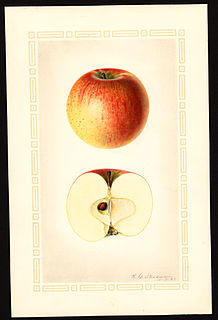
The origins of the Rambo apple cultivar are unknown. It may date back to the American colony of New Sweden, when in 1637 Peter Gunnarsson Rambo, a Swedish immigrant, arrived on the Kalmar Nyckel. Swedish natural historian Pehr Kalm, who wrote Travels in North America, 1747–51, took notes of his interview with Mr. Peter Rambo, grandson of Peter Gunnarsson Rambo, recording that the ″original Peter Rambo had brought apple seeds and several other tree and garden seeds with him in a box.″ The first Rambo apple tree was very likely grown from one of these seeds. There is no certainty, however, since the earliest documented mention of the apple variety's origin occurs in William Coxe's A View of the Cultivation of Fruit Trees, and the Management of Orchards and Cider, published in 1817. Coxe wrote only that the Rambo was much cultivated in Delaware, Pennsylvania, and New Jersey and took "its name from the families by whom it was introduced into notice."
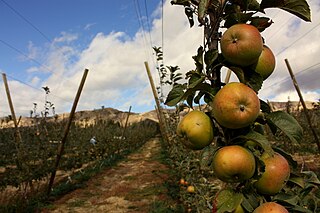
The Newtown Pippin, also known as Albemarle Pippin, is an American apple that originated in the late 17th or early 18th century and is still cultivated on a small scale. At one time, there were two very similar apple cultivars known as the 'Yellow Newtown' and 'Green Newtown', one of which perhaps originated as a sport of the other.
The "Taliaferro", "Robinson" or "Robertson" was a small-sized apple grown at Monticello by Thomas Jefferson. This cultivar appears to be extinct, though some horticulturalists assert that the 'Highland County' cultivar may be related, or even the same cultivar under a different name.

The Calville Blanc d'hiver is an apple cultivar. It originated in France in the 17th century from a chance seedling.

The Gardens of Monticello were gardens first designed by Thomas Jefferson for his plantation Monticello near Charlottesville, Virginia. Jefferson's detailed historical accounts of his 5,000 acres provide much information about the ever-changing contents of the gardens. The areas included a flower garden, a fruit orchard, and a vegetable garden. Jefferson, a connoisseur of trees, flowers, and gardening techniques, was highly interested in experimental planting and directed the design of the gardens, which contained many exotic seeds and plants from his travels abroad.

Bismarck is an apple cultivar. The fruit from the tree is used for cooking due to its sharp flavour and is most commonly pureed when cooking.

'Tompkins King' is a triploid cultivar of apple, also called 'King' or 'King of Tompkins County'. It was thought to have originated at Jacksonville in Tompkins County, New York, but Liberty Hyde Bailey investigated the tree there, and discovered that it was grafted. The cultivar was apparently brought from Warren County, New Jersey in 1804.

Manks Codlin is an early cultivar selected from the domesticated apple that were growing at Isle of Man. It has many other names, including 'Winter Saint Lawrence' and 'Eva'. It first fruited in 1815. This cultivar is considered particularly cold hardy and well suited to exposed sites and poor soils.

'Duchess of Oldenburg' is an old Russian cultivar of cultivated apple which has attractive streaks of yellow and red. It was commonly but not universally known in America simply as 'Oldenburg' after the American Pomological Society listed that as the official name, a name also used for the 'Geheimrat Dr. Oldenburg' cultivar. The skin of the apple is more prominently striped than that of 'Geheimrat Dr. Oldenburg'.

Wolf River is an American cultivar of domesticated apple, which originates from the shores of the Wolf River of Wisconsin, in the United States of America, known since 1875. The tree is exceptionally frost hardy and generally disease resistant, and thus keeps well in storage. The fruit usually ripens mid-September to early October. It is large, commonly weighing over a pound, and fairly sweet with a distinctive red and yellow appearance. It has many culinary uses, as it keeps its shape well when cooked.
The Hewe's Crab (also called Virginia Crab, Hughes's Crab and Red Hughes, is a small-sized apple that was popular for cider making in the southern United States in the 18th and 19th centuries and was grown at Monticello by Thomas Jefferson.
'Clarke Pearmain', also called 'Golden Pearmain', 'Glouster Pearmain, 'Yellow Pearmain', and possibly the same as 'Columbian Russet', is a medium-sized apple cultivar. It was grown at Monticello by Thomas Jefferson.

Dumelow's Seedling is a cultivar of domesticated apple that originated at Shackerstone in Leicestershire where it was grown by Richard Dumeller in 1800. It is known by many other names including 'Dumelow's Crab', 'Wellington', 'Doncklaer', 'Beauty', and 'Belle de Vennes'. The fruit is not ready for harvest until October, being one of the last of the season, and keeps well into the next year. Though inferior for use as a dessert apple it cooks well and in early-20th century England was one of the most valuable varieties of cooking apple.


















